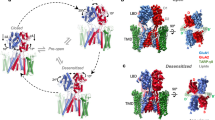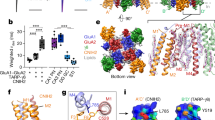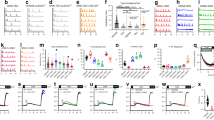Abstract
The function, trafficking and synaptic signaling of AMPA receptors are tightly regulated by phosphorylation. Ca2+/calmodulin-dependent kinase II (CaMKII) phosphorylates the GluA1 AMPA receptor subunit at Ser831 to increase single-channel conductance. We show that CaMKII increases the conductance of native heteromeric AMPA receptors in mouse hippocampal neurons through phosphorylation of Ser831. In addition, co-expression of transmembrane AMPA receptor regulatory proteins (TARPs) with recombinant receptors is required for phospho-Ser831 to increase conductance of heteromeric GluA1-GluA2 receptors. Finally, phosphorylation of Ser831 increases the efficiency with which each subunit can activate, independent of agonist efficacy, thereby increasing the likelihood that more receptor subunits will be simultaneously activated during gating. This underlies the observation that phospho-Ser831 increases the frequency of openings to larger conductances rather than altering unitary conductance. Together, these findings suggest that CaMKII phosphorylation of GluA1-Ser831 decreases the activation energy for an intrasubunit conformational change that regulates the conductance of the receptor when the channel pore opens.
This is a preview of subscription content, access via your institution
Access options
Subscribe to this journal
Receive 12 print issues and online access
$209.00 per year
only $17.42 per issue
Buy this article
- Purchase on Springer Link
- Instant access to full article PDF
Prices may be subject to local taxes which are calculated during checkout





Similar content being viewed by others
References
Traynelis, S.F. et al. Glutamate receptor ion channels: structure, regulation, and function. Pharmacol. Rev. 62, 405–496 (2010).
Malinow, R. & Malenka, R.C. AMPA receptor trafficking and synaptic plasticity. Annu. Rev. Neurosci. 25, 103–126 (2002).
Sobolevsky, A.I., Rosconi, M.P. & Gouaux, E. X-ray structure, symmetry and mechanism of an AMPA-subtype glutamate receptor. Nature 462, 745–756 (2009).
Derkach, V., Barria, A. & Soderling, T.R. Ca2+/calmodulin-kinase II enhances channel conductance of α-amino-3-hydroxy-5-methyl-4-isoxazolepropionate type glutamate receptors. Proc. Natl. Acad. Sci. USA 96, 3269–3274 (1999).
Barria, A., Derkach, V. & Soderling, T. Identification of the Ca2+/calmodulin-dependent protein kinase II regulatory phosphorylation site in the α-amino-3-hydroxyl-5-methyl-4-isoxazole-propionate-type glutamate receptor. J. Biol. Chem. 272, 32727–32730 (1997).
Shepherd, J.D. & Huganir, R.L. The cell biology of synaptic plasticity: AMPA receptor trafficking. Annu. Rev. Cell Dev. Biol. 23, 613–643 (2007).
Tomita, S. et al. Stargazin modulates AMPA receptor gating and trafficking by distinct domains. Nature 435, 1052–1058 (2005).
Banke, T.G. et al. Control of GluR1 AMPA receptor function by cAMP-dependent protein kinase. J. Neurosci. 20, 89–102 (2000).
Holmes, W.R. & Grover, L.M. Quantifying the magnitude of changes in synaptic level parameters with long-term potentiation. J. Neurophysiol. 96, 1478–1491 (2006).
Benke, T.A., Lüthi, A., Isaac, J.T. & Collingridge, G.L. Modulation of AMPA receptor unitary conductance by synaptic activity. Nature 393, 793–797 (1998).
Malenka, R.C., Kauer, J.A., Zucker, R.S. & Nicoll, R.A. Postsynaptic calcium is sufficient for potentiation of hippocampal synaptic transmission. Science 242, 81–84 (1988).
Lee, H.K. et al. Phosphorylation of the AMPA receptor GluR1 subunit is required for synaptic plasticity and retention of spatial memory. Cell 112, 631–643 (2003).
Lee, H.K., Barbarosie, M., Kameyama, K., Bear, M.F. & Huganir, R.L. Regulation of distinct AMPA receptor phosphorylation sites during bidirectional synaptic plasticity. Nature 405, 955–959 (2000).
Silva, A.J., Stevens, C.F., Tonegawa, S. & Wang, Y. Deficient hippocampal long-term potentiation in α-calcium-calmodulin kinase II mutant mice. Science 257, 201–206 (1992).
Lamsa, K., Irvine, E.E., Giese, K.P. & Kullmann, D.M. NMDA receptor-dependent long-term potentiation in mouse hippocampal interneurons shows a unique dependence on Ca2+/calmodulin-dependent kinases. J. Physiol. (Lond.) 584, 885–894 (2007).
Lee, H.K., Takamiya, K., He, K., Song, L. & Huganir, R.L. Specific roles of AMPA receptor subunit GluR1 (GluA1) phosphorylation sites in regulating synaptic plasticity in the CA1 region of hippocampus. J. Neurophysiol. 103, 479–489 (2010).
Barria, A., Muller, D., Derkach, V., Griffith, L.C. & Soderling, T.R. Regulatory phosphorylation of AMPA-type glutamate receptors by CaM-KII during long-term potentiation. Science 276, 2042–2045 (1997).
Mammen, A.L., Kameyama, K., Roche, K.W. & Huganir, R.L. Phosphorylation of the α-amino-3-hydroxy-5-methylisoxazole4-propionic acid receptor GluR1 subunit by calcium/calmodulin-dependent kinase II. J. Biol. Chem. 272, 32528–32533 (1997).
Hayashi, Y. et al. Driving AMPA receptors into synapses by LTP and CaMKII: requirement for GluR1 and PDZ domain interaction. Science 287, 2262–2267 (2000).
Lüthi, A. et al. Bi-directional modulation of AMPA receptor unitary conductance by synaptic activity. BMC Neurosci. 5, 44 (2004).
Poncer, J.C., Esteban, J.A. & Malinow, R. Multiple mechanisms for the potentiation of AMPA receptor-mediated transmission by α-Ca2+/calmodulin-dependent protein kinase II. J. Neurosci. 22, 4406–4411 (2002).
Palmer, M.J., Isaac, J.T. & Collingridge, G.L. Multiple, developmentally regulated expression mechanisms of long-term potentiation at CA1 synapses. J. Neurosci. 24, 4903–4911 (2004).
Smith, T.C. & Howe, J.R. Concentration-dependent substate behavior of native AMPA receptors. Nat. Neurosci. 3, 992–997 (2000).
Poon, K., Nowak, L.M. & Oswald, R.E. Characterizing single-channel behavior of GluA3 receptors. Biophys. J. 99, 1437–1446 (2010).
Rosenmund, C., Stern-Bach, Y. & Stevens, C.F. The tetrameric structure of a glutamate receptor channel. Science 280, 1596–1599 (1998).
Jin, R., Banke, T.G., Mayer, M.L., Traynelis, S.F. & Gouaux, E. Structural basis for partial agonist action at ionotropic glutamate receptors. Nat. Neurosci. 6, 803–810 (2003).
Prieto, M.L. & Wollmuth, L.P. Gating modes in AMPA receptors. J. Neurosci. 30, 4449–4459 (2010).
Wenthold, R.J., Petralia, R.S., Blahos, J. II & Niedzielski, A.S. Evidence for multiple AMPA receptor complexes in hippocampal CA1/CA2 neurons. J. Neurosci. 16, 1982–1989 (1996).
Traynelis, S.F. & Jaramillo, F. Getting the most out of noise in the central nervous system. Trends Neurosci. 21, 137–145 (1998).
Derkach, V.A. Silence analysis of AMPA receptor mutated at the CaM-kinase II phosphorylation site. Biophys. J. 84, 1701–1708 (2003).
Swanson, G.T., Kamboj, S.K. & Cull-Candy, S.G. Single-channel properties of recombinant AMPA receptors depend on RNA editing, splice variation, and subunit composition. J. Neurosci. 17, 58–69 (1997).
Tomita, S., Stein, V., Stocker, T.J., Nicoll, R.A. & Bredt, D.S. Bidirectional synaptic plasticity regulated by phosphorylation of stargazin-like TARPs. Neuron 45, 269–277 (2005).
Oh, M.C. & Derkach, V.A. Dominant role of the GluR2 subunit in regulation of AMPA receptors by CaMKII. Nat. Neurosci. 8, 853–854 (2005).
Stern-Bach, Y., Russo, S., Neuman, M. & Rosenmund, C. A point mutation in the glutamate binding site blocks desensitization of AMPA receptors. Neuron 21, 907–918 (1998).
Deng, F., Price, M.G., Davis, C.F., Mori, M. & Burgess, D.L. Stargazin and other transmembrane AMPA receptor regulating proteins interact with synaptic scaffolding protein MAGI-2 in brain. J. Neurosci. 26, 7875–7884 (2006).
Soto, D., Coombs, I.D., Kelly, L., Farrant, M. & Cull-Candy, S.G. Stargazin attenuates intracellular polyamine block of calcium-permeable AMPA receptors. Nat. Neurosci. 10, 1260–1267 (2007).
Milstein, A.D. & Nicoll, R.A. TARP modulation of synaptic AMPA receptor trafficking and gating depends on multiple intracellular domains. Proc. Natl. Acad. Sci. USA 106, 11348–11351 (2009).
Milstein, A.D., Zhou, W., Karimzadegan, S., Bredt, D.S. & Nicoll, R.A. TARP subtypes differentially and dose-dependently control synaptic AMPA receptor gating. Neuron 55, 905–918 (2007).
Nicoll, R.A., Tomita, S. & Bredt, D.S. Auxiliary subunits assist AMPA-type glutamate receptors. Science 311, 1253–1256 (2006).
Hogner, A. et al. Structural basis for AMPA receptor activation and ligand selectivity: crystal structures of five agonist complexes with the GluR2 ligand-binding core. J. Mol. Biol. 322, 93–109 (2002).
Frandsen, A. et al. Tyr702 is an important determinant of agonist binding and domain closure of the ligand-binding core of GluR2. Mol. Pharmacol. 67, 703–713 (2005).
Traynelis, S.F. & Wahl, P. Control of rat GluR6 glutamate receptor open probability by protein kinase A and calcineurin. J. Physiol. (Lond.) 503, 513–531 (1997).
Roche, K.W., O′Brien, R.J., Mammen, A.L., Bernhardt, J. & Huganir, R.L. Characterization of multiple phosphorylation sites on the AMPA receptor GluR1 subunit. Neuron 16, 1179–1188 (1996).
Boehm, J. et al. Synaptic incorporation of AMPA receptors during LTP is controlled by a PKC phosphorylation site on GluR1. Neuron 51, 213–225 (2006).
Lin, D.T. et al. Regulation of AMPA receptor extrasynaptic insertion by 4.1N, phosphorylation and palmitoylation. Nat. Neurosci. 12, 879–887 (2009).
Tavalin, S.J. AKAP79 selectively enhances protein kinase C regulation of GluR1 at a Ca2+-calmodulin-dependent protein kinase II/protein kinase C site. J. Biol. Chem. 283, 11445–11452 (2008).
Lisman, J. & Raghavachari, S. A unified model of the presynaptic and postsynaptic changes during LTP at CA1 synapses. Sci. STKE 2006, re11 (2006).
Lee, H.K. et al. Identification and characterization of a novel phosphorylation site on the GluR1 subunit of AMPA receptors. Mol. Cell. Neurosci. 36, 86–94 (2007).
Delgado, J.Y. et al. NMDA receptor activation dephosphorylates AMPA receptor glutamate receptor 1 subunits at threonine 840. J. Neurosci. 27, 13210–13221 (2007).
Serulle, Y. et al. A GluR1-cGKII interaction regulates AMPA receptor trafficking. Neuron 56, 670–688 (2007).
Acknowledgements
We thank V. Derkach and J. Howe for comments on the manuscript. We thank D. Colquhoun (University College London) for providing software for time course fitting and single channel dwell time and amplitude analysis (SCAN, EKDIST). GluA1 and GluA2 cDNA was provided by P. Seeburg (Max-Planck-Institut für medizinische Forschung) and γ8 cDNA by R. Nicoll (University of California, San Francisco). This work was supported by the US National Institutes of Health (NS068464, NS036654; S.F.T.), the Howard Hughes Medical Institute (R.H.), the Alfred Benzon Foundation (A.S.K., T.G.B.) and the Lundbeck Foundation (A.S.).
Author information
Authors and Affiliations
Contributions
A.S.K. and M.A.J. performed patch clamp recordings from recombinant and neuronal receptors; M.A.J. performed all recordings with neurons from transgenic animals. T.G.B. performed a subset of rapid agonist application experiments onto recombinant receptors. Y.M., R.C.J. and R.H. generated knock-in mice for this study. T.G.B. and A.S. performed Xenopus oocyte recordings. S.F.T. assisted with experimental design and participated in data analysis and interpretation. All authors contributed to writing the manuscript.
Corresponding author
Ethics declarations
Competing interests
The authors declare no competing financial interests.
Supplementary information
Supplementary Text and Figures
Supplementary Figures 1–2 and Supplementary Table 1 (PDF 471 kb)
Rights and permissions
About this article
Cite this article
Kristensen, A., Jenkins, M., Banke, T. et al. Mechanism of Ca2+/calmodulin-dependent kinase II regulation of AMPA receptor gating. Nat Neurosci 14, 727–735 (2011). https://doi.org/10.1038/nn.2804
Received:
Accepted:
Published:
Issue Date:
DOI: https://doi.org/10.1038/nn.2804
This article is cited by
-
Excitation–transcription coupling, neuronal gene expression and synaptic plasticity
Nature Reviews Neuroscience (2023)
-
PDI augments kainic acid-induced seizure activity and neuronal death by inhibiting PP2A-GluA2-PICK1-mediated AMPA receptor internalization in the mouse hippocampus
Scientific Reports (2023)
-
LTP induction by structural rather than enzymatic functions of CaMKII
Nature (2023)
-
Interleukin-13 and its receptor are synaptic proteins involved in plasticity and neuroprotection
Nature Communications (2023)
-
Clinical and functional consequences of GRIA variants in patients with neurological diseases
Cellular and Molecular Life Sciences (2023)



